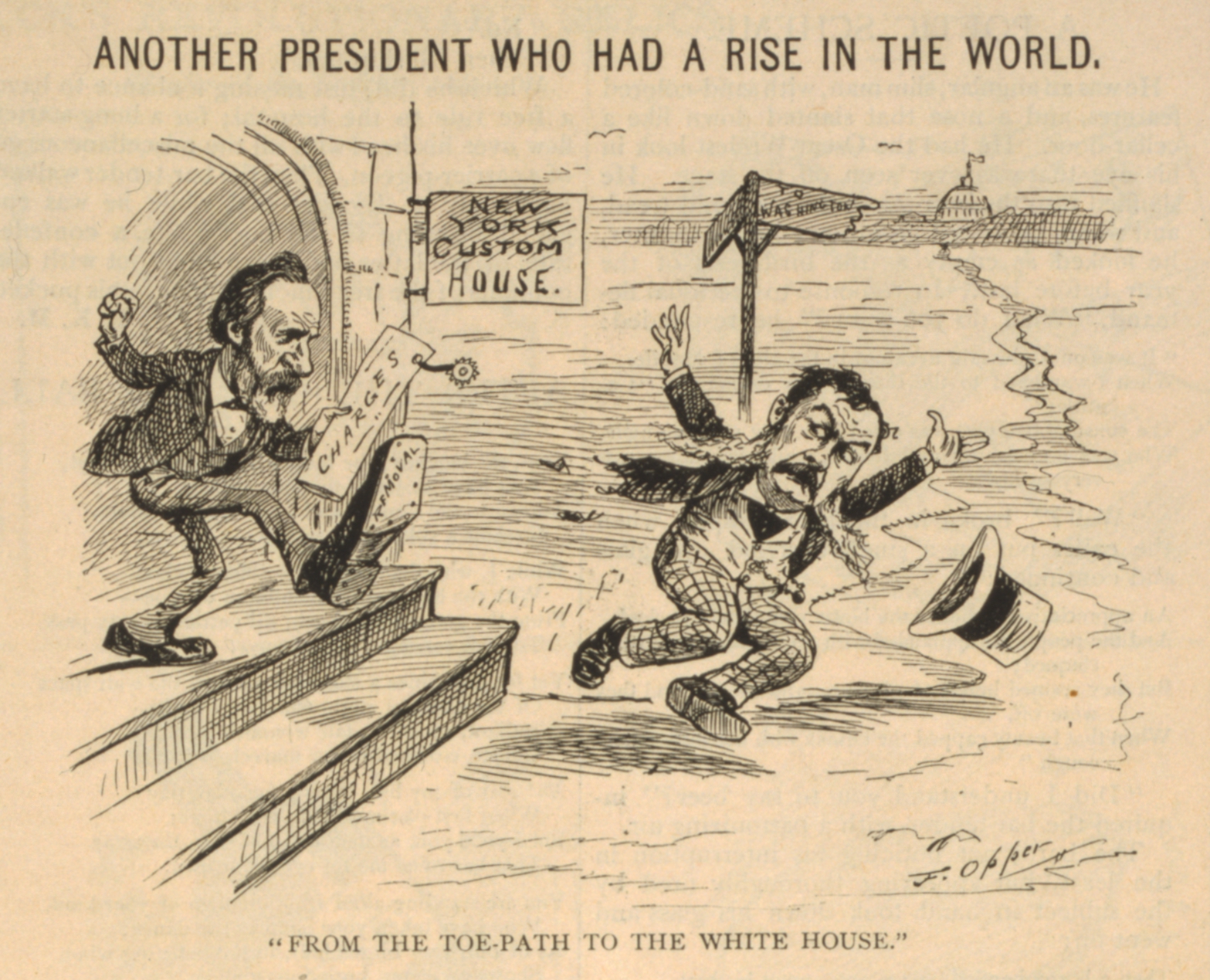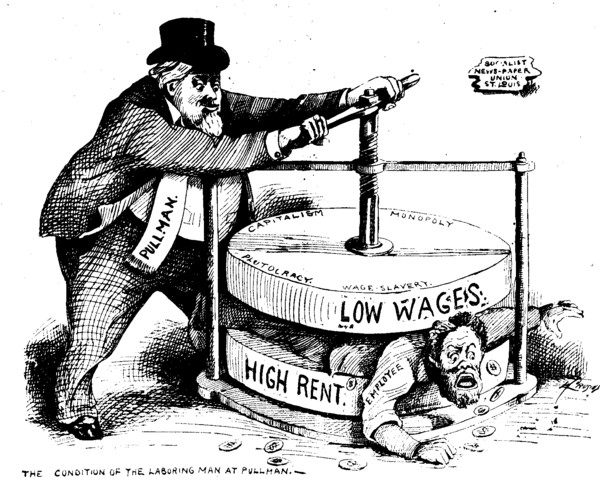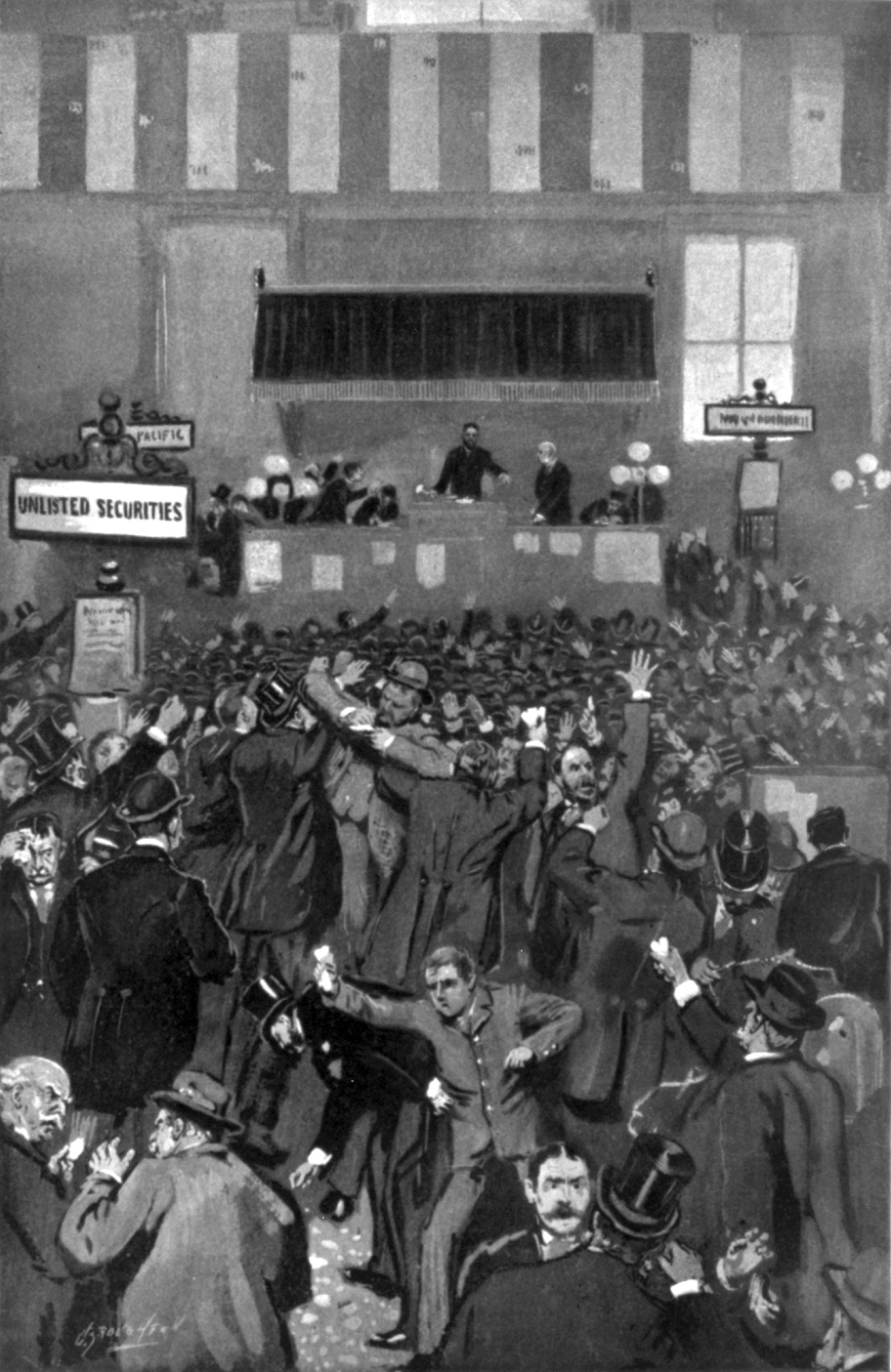|
Cleveland Presidency
Grover Cleveland was the president of the United States first from March 4, 1885, to March 4, 1889, and then from March 4, 1893, to March 4, 1897. The first Democrat elected after the Civil War, Cleveland is the only US president to leave office after one term and later return for a second term. His presidencies were the nation's 22nd and 24th. Cleveland defeated James G. Blaine of Maine in 1884, lost to Benjamin Harrison of Indiana in 1888, and then defeated President Harrison in 1892. Cleveland won the 1884 election with the support of a reform-minded group of Republicans known as Mugwumps, and he expanded the number of government positions that were protected by the Pendleton Civil Service Reform Act. He also vetoed several bills designed to provide pensions and other benefits to various regions and individuals. In response to anti-competitive practices by railroads, Cleveland signed the Interstate Commerce Act of 1887, which established the first independent federal agency ... [...More Info...] [...Related Items...] OR: [Wikipedia] [Google] [Baidu] |
Democratic Party (United States)
The Democratic Party is one of the two major contemporary political parties in the United States. Founded in 1828, it was predominantly built by Martin Van Buren, who assembled a wide cadre of politicians in every state behind war hero Andrew Jackson, making it the world's oldest active political party.M. Philip Lucas, "Martin Van Buren as Party Leader and at Andrew Jackson's Right Hand." in ''A Companion to the Antebellum Presidents 1837–1861'' (2014): 107–129."The Democratic Party, founded in 1828, is the world's oldest political party" states Its main political rival has been the Republican Party since the 1850s. The party is a big tent, and though it is often described as liberal, it is less ideologically uniform than the Republican Party (with major individuals within it frequently holding widely different political views) due to the broader list of unique voting blocs that compose it. The historical predecessor of the Democratic Party is considered to be th ... [...More Info...] [...Related Items...] OR: [Wikipedia] [Google] [Baidu] |
Pendleton Civil Service Reform Act
The Pendleton Civil Service Reform Act is a United States federal law passed by the 47th United States Congress and signed into law by President Chester A. Arthur on January 16, 1883. The act mandates that most positions within the federal government should be awarded on the basis of merit instead of political patronage. By the late 1820s, American politics operated on the spoils system, a political patronage practice in which officeholders awarded their allies with government jobs in return for financial and political support. Proponents of the spoils system were successful at blocking meaningful civil service reform until the assassination of President James A. Garfield in 1881. The 47th Congress passed the Pendleton Civil Service Reform Act during its lame duck session and President Chester A. Arthur, himself a former spoilsman, signed the bill into law. The Pendleton Civil Service Act provided for the selection of some government employees by competitive exams, rather than ti ... [...More Info...] [...Related Items...] OR: [Wikipedia] [Google] [Baidu] |
Hawaii
Hawaii ( ; haw, Hawaii or ) is a state in the Western United States, located in the Pacific Ocean about from the U.S. mainland. It is the only U.S. state outside North America, the only state that is an archipelago, and the only state geographically located within the tropics. Hawaii comprises nearly the entire Hawaiian archipelago, 137 volcanic islands spanning that are physiographically and ethnologically part of the Polynesian subregion of Oceania. The state's ocean coastline is consequently the fourth-longest in the U.S., at about . The eight main islands, from northwest to southeast, are Niihau, Kauai, Oahu, Molokai, Lānai, Kahoolawe, Maui, and Hawaii—the last of these, after which the state is named, is often called the "Big Island" or "Hawaii Island" to avoid confusion with the state or archipelago. The uninhabited Northwestern Hawaiian Islands make up most of the Papahānaumokuākea Marine National Monument, the United States' largest protected ... [...More Info...] [...Related Items...] OR: [Wikipedia] [Google] [Baidu] |
Pullman Strike
The Pullman Strike was two interrelated strikes in 1894 that shaped national labor policy in the United States during a period of deep economic depression. First came a strike by the American Railway Union (ARU) against the Pullman factory in Chicago in spring 1894. When it failed, the ARU launched a national boycott against all trains that carried Pullman passenger cars. The nationwide railroad boycott that lasted from May 11 to July 20, 1894, was a turning point for US labor law. It pitted the American Railway Union (ARU) against the Pullman Company, the main railroads, the main labor unions, and the federal government of the United States under President Grover Cleveland. The strike and boycott shut down much of the nation's freight and passenger traffic west of Detroit, Michigan. The conflict began in Chicago, on May 11 when nearly 4,000 factory employees of the Pullman Company began a wildcat strike in response to recent reductions in wages. Most of the factory workers who ... [...More Info...] [...Related Items...] OR: [Wikipedia] [Google] [Baidu] |
Wilson–Gorman Tariff Act
The Revenue Act or Wilson-Gorman Tariff of 1894 (ch. 349, §73, , August 27, 1894) slightly reduced the United States tariff rates from the numbers set in the 1890 McKinley tariff and imposed a 2% tax on income over $4,000. It is named for William L. Wilson, Representative from West Virginia, chair of the U.S. House Ways and Means Committee, and Senator Arthur P. Gorman of Maryland, both Democrats. Supported by pro-free trade members of the Democratic Party, this attempt at tariff reform imposed the first peacetime income tax (2% on income over $4,000, or $88,100 in 2010 dollars, which meant fewer than 1% of households would pay any). The purpose of the income tax was to make up for revenue that would be lost by tariff reductions. The democrats under the Cleveland administration wanted to move away from the protectionism proposed by the McKinley tariff while Cleveland was still in office. By coincidence, $4,000 ($88,100 in 2010 dollars) would be the exemption for married c ... [...More Info...] [...Related Items...] OR: [Wikipedia] [Google] [Baidu] |
Free Silver
Free silver was a major economic policy issue in the United States in the late 19th-century. Its advocates were in favor of an expansionary monetary policy featuring the unlimited coinage of silver into money on-demand, as opposed to strict adherence to the more carefully fixed money supply implicit in the gold standard. Free silver became increasingly associated with populism, unions, and the fight of ordinary Americans against the bankers and monopolists, and the robber baron (industrialist), robber barons of the Gilded Age capitalism era and was referred to as the "People's Money". Supporters of an important place for silver in a bimetallism, bimetallic money system making use of both silver and gold, called "Silverites", sought coinage of silver dollars at a fixed weight ratio of 16-to-1 against dollar coins made of gold. Because the actual price ratio of the two metals was substantially higher in favor of gold at the time, most economists warned that the less valuable silver ... [...More Info...] [...Related Items...] OR: [Wikipedia] [Google] [Baidu] |
Sherman Silver Purchase Act
The Sherman Silver Purchase Act was a United States federal law enacted on July 14, 1890.Charles Ramsdell Lingley, ''Since the Civil War'', first edition: New York, The Century Co., 1920, ix–635 p., . Re-issued: Plain Label Books, unknown date, under a new title: ''The United States Since the Civil War'', 310 p. See: page 173(Google Books). The measure did not authorize the free and unlimited coinage of silver that the Free Silver supporters wanted; however, it increased the amount of silver the government was required to purchase on a recurrent monthly basis to 4.5 million ounces.Homer E. Socolofsky and Allen B. Spetter, ''The Presidency of Benjamin Harrison'', p. 59. The Sherman Silver Purchase Act had been passed in response to the growing complaints of farmers' and miners' interests. Farmers had immense debts that could not be paid off due to deflation, and they urged the government to pass the Sherman Silver Purchase Act in order to boost the economy and cause inflation, a ... [...More Info...] [...Related Items...] OR: [Wikipedia] [Google] [Baidu] |
Panic Of 1893
The Panic of 1893 was an economic depression in the United States that began in 1893 and ended in 1897. It deeply affected every sector of the economy, and produced political upheaval that led to the political realignment of 1896 and the presidency of William McKinley. Causes The Panic of 1893 has been traced to many causes, one of those points to Argentina; investment was encouraged by the Argentine agent bank, Baring Brothers. However, the 1890 wheat crop failure and a failed coup in Buenos Aires ended further investments. In addition, speculations in South African and Australian properties also collapsed. Because European investors were concerned that these problems might spread, they started a run on gold in the U.S. Treasury. Specie was considered more valuable than paper money; when people were uncertain about the future, they hoarded specie and rejected paper notes.Nelson, Scott Reynolds. 2012. A Nation of Deadbeats. New York: Alfred Knopf, p. 189. During the Gi ... [...More Info...] [...Related Items...] OR: [Wikipedia] [Google] [Baidu] |
Samoan Islands
The Samoan Islands ( sm, Motu o Sāmoa) are an archipelago covering in the central South Pacific, forming part of Polynesia and of the wider region of Oceania. Administratively, the archipelago comprises all of the Independent State of Samoa and most of American Samoa (apart from Swains Island, which is geographically part of the Tokelau Islands). The land masses of the two Samoan jurisdictions are separated by of ocean at their closest points. The population of the Samoan Islands is approximately 250,000. The inhabitants have in common the Samoan language, a culture known as '' fa'a Samoa,'' and an indigenous form of governance called '' fa'amatai''. Samoans are one of the largest Polynesian populations in the world, and most are of exclusively Samoan ancestry. The oldest known evidence of human activity in the Samoan Islands dates to around 1050 BCE. It comes from a Lapita site at Mulifanua wharf on Upolu island. In 1768, the eastern islands were visited by the French ... [...More Info...] [...Related Items...] OR: [Wikipedia] [Google] [Baidu] |
Samoan Crisis
The Samoan Crisis was a standoff between the United States, the German Empire, and the British Empire from 1887 to 1889 over control of the Samoan Islands during the First Samoan Civil War. Background In 1878, the United States acquired a fuelling station at the harbor at Pago Pago, on the island of Tutuila, in exchange for providing guarantees of protection to Samoa. The German Empire on the other hand desired concessions at the harbor at Apia, on the island of Upolu. Incident The incident involved three US Navy warships (the sloop-of-war , the screw steamer , and the gunboat ) and three German warships (the gunboats and and the corvette ), which kept each other at bay over several months in Apia Harbour, which was monitored by the British corvette . The standoff ended when the 1889 Apia cyclone, on 15 and 16 March, wrecked all six warships in the harbour. ''Calliope'' escaped the harbour and thus survived the storm. Robert Louis Stevenson did not witness the storm and its ... [...More Info...] [...Related Items...] OR: [Wikipedia] [Google] [Baidu] |
Tariffs In United States History
Tariffs have historically served a key role in the trade policy of the United States. Their purpose was to generate revenue for the federal government and to allow for import substitution industrialization (industrialization of a nation by replacing foreign imports with domestic production) by acting as a protective barrier around infant industries. They also aimed to reduce the trade deficit and the pressure of foreign competition. Tariffs were one of the pillars of the American System that allowed the rapid development and industrialization of the United States. The United States pursued a protectionist policy from the beginning of the 19th century until the middle of the 20th century. Between 1861 and 1933, they had one of the highest average tariff rates on manufactured imports in the world. However American agricultural and industrial were cheaper than rival products and the tariff had an impact primarily on wool products. After 1942 the U.S. promoted worldwide free trad ... [...More Info...] [...Related Items...] OR: [Wikipedia] [Google] [Baidu] |
Bland–Allison Act
The Bland–Allison Act, also referred to as the Grand Bland Plan of 1878, was an act of United States Congress requiring the U.S. Treasury to buy a certain amount of silver and put it into circulation as silver dollars. Though the bill was vetoed by President Rutherford B. Hayes, the Congress overrode Hayes's veto on February 28, 1878 to enact the law. The text of the act can be found in the ''Congressional Record'' under the further reading section of this article. Background The five-year depression following the Panic of 1873 caused cheap-money advocates (led by Representative Richard P. Bland, a Democrat of Missouri), to join with silver-producing interests in urging a return to bimetallism, the use of both silver and gold as a standard. Coupled with Senator William B. Allison of Iowa, they agreed to a proposal that allowed silver to be purchased at market rates, metals to be minted into silver dollars, and required the US Treasury to purchase between $2 million to $4 milli ... [...More Info...] [...Related Items...] OR: [Wikipedia] [Google] [Baidu] |






.png)